
by Larry Williams | Jul 15, 2021
Q. One of my two fig trees has produced a few figs. The other one, which is the largest and healthiest tree, has never had a fig on it. Both where planted six years ago. Why is it not producing?
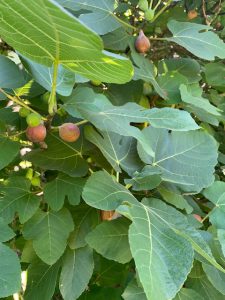
Mature fig tree with fruit. Photo credit: Larry Williams
A. It may be a matter of age and being overly vigorous. When a fruit tree is younger, it puts most of its energy into producing leaves and shoots. Until the plant becomes mature and slows down in the production of leaves and shoots, it will produce few to no fruit. It may take a year or two more for your tree to slowly and gradually switch from producing mostly leaves and shoots to producing and maturing some fruit. Patience is needed.
Be careful to not overdo it in fertilizing and/or pruning your fig tree. Too much fertilizer, especially nitrogen, or severely pruning the tree will result in the tree becoming overly vigorous at the expense of setting and maturing fruit. This includes fertilizer that the tree may pull up from a nearby lawn area. A tree’s roots will grow outward two to three times beyond its branch spread into adjacent lawn areas.
The end result of being heavy handed with fertilizing and/or overdoing it in pruning is the same – it forces the plant to become overly vigorous in producing leaves and shoots at the expense of producing and maturing fruit.
In addition, the following is taken from an Extension publication on figs and includes the most common reasons for lack of fruiting, in order of importance.
- Young, vigorous plants and over-fertilized plants will often produce fruit that drops off before maturing. If plants are excessively vigorous, stop fertilizing them. Quite often, three of four years may pass before the plant matures a crop because figs have a long juvenile period before producing edible quality fruit.
- Dry, hot periods that occur before ripening can cause poor fruit quality. If this is the case, mulching and supplemental watering during dry spells will reduce the problem.
- The variety Celeste will often drop fruit prematurely in hot weather regardless of the quality of plant care. However, it is still a good variety to grow.
- An infestation of root-knot nematodes can intensify the problem when conditions are as described in item 2.
- You could have a fig tree that requires cross-pollination by a special wasp. This is a rare problem. If this is the case, then it will never set a good crop. The best way to resolve this is to replace the plant with a rooted shoot of a neighbor’s plant you know produces a good crop each year.
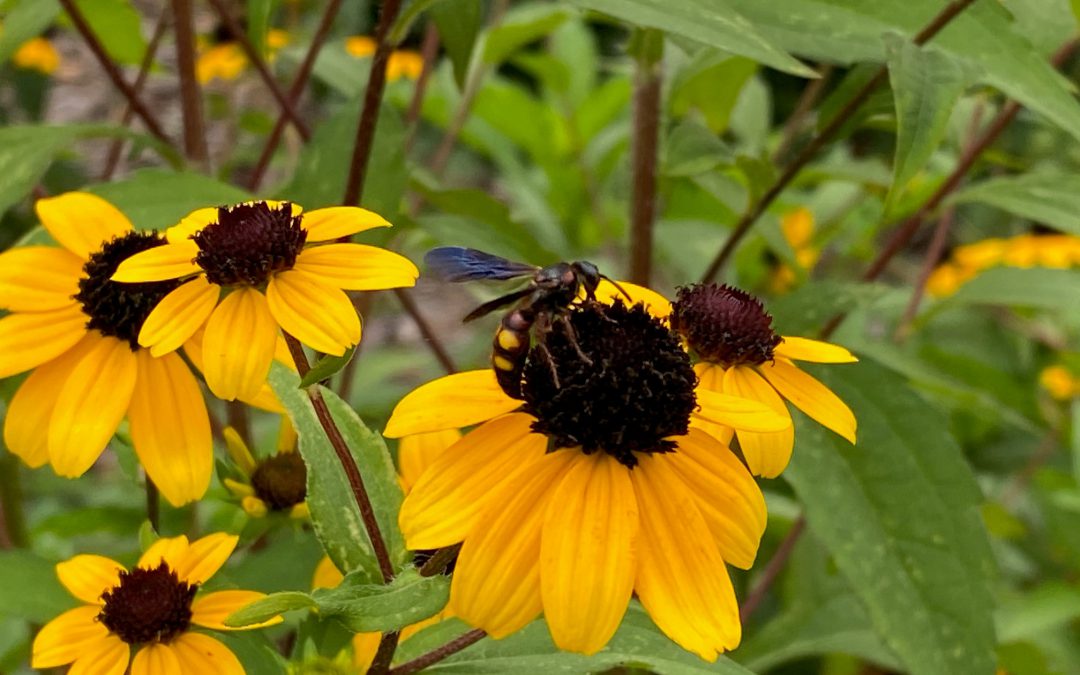
by Mary Salinas | Jul 15, 2021
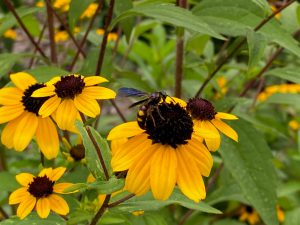
Brown-eyed Susan makes a nice addition to a pollinator garden. This one is visited by a scoliid wasp, a parasitoid of soil-inhabiting scarab beetle larvae. Photo credit: Mary Salinas, UF/IFAS Extension.
Black-eyed Susan, Rudbeckia hirta, has been a very popular garden perennial for generations. Fewer gardeners have experience with, or even heard of its’ close relative, brown-eyed Susan, Rudbeckia triloba. So, what is the difference between them?
- Brown-eyed Susan has more numerous flowers and generally flowers for a longer period in spring, summer, and fall.
- Black-eyed Susan has bigger flowers and bigger leaves.
- Both species are perennial, but the brown-eyed Susan tends to die out sooner after a few years. The good news is that both readily spread through seed to replace older plants.
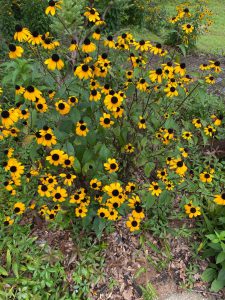
Brown-eyed Susan. Photo credit: Mary Salinas, UF/IFAS Extension.
Brown-eyed Susan is native to the eastern and central United States and, although native to Florida, it has only been vouchered in the wild in 5 counties in Florida. Gardeners can find seed and plants readily online and at a few native plant nurseries. It is best to try to source wildflower seed from plants grown in the same region. Brown-eyed Susan seed from plants grown in Nebraska or Michigan may not be as well adapted to the Florida environment as locally grown seed.
If you want to add this pollinator attracting perennial to your garden, choose a spot that is sunny or partly sunny. Although it prefers moist soil, brown eyed Susan adapts to most soil types and is drought tolerant after establishment.
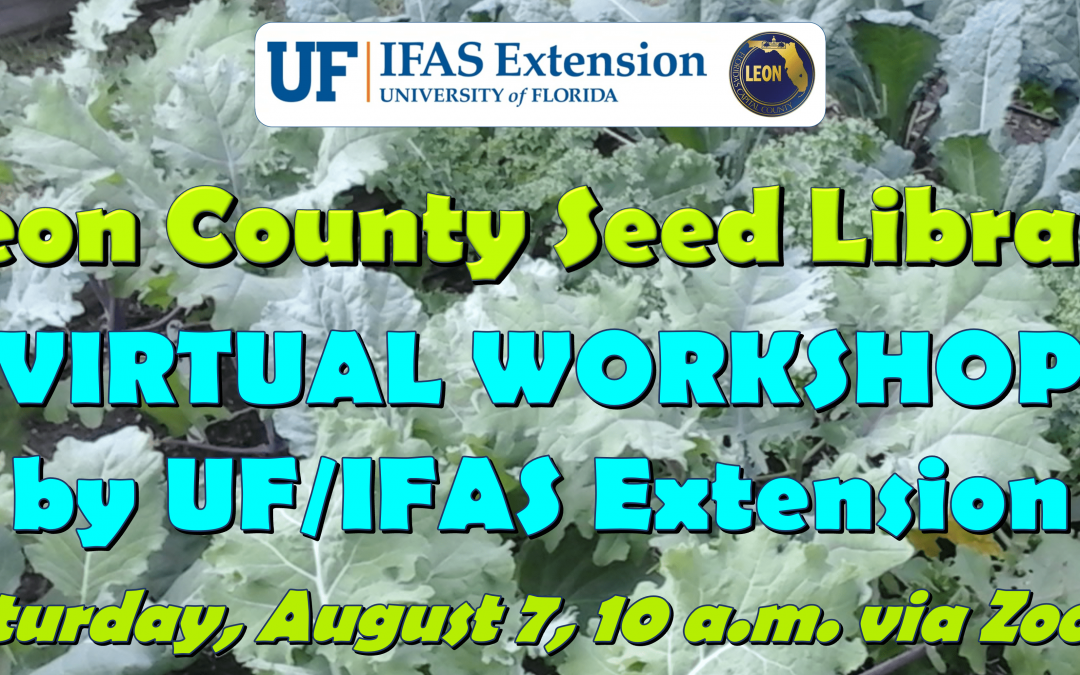
by Molly Jameson | Jul 15, 2021
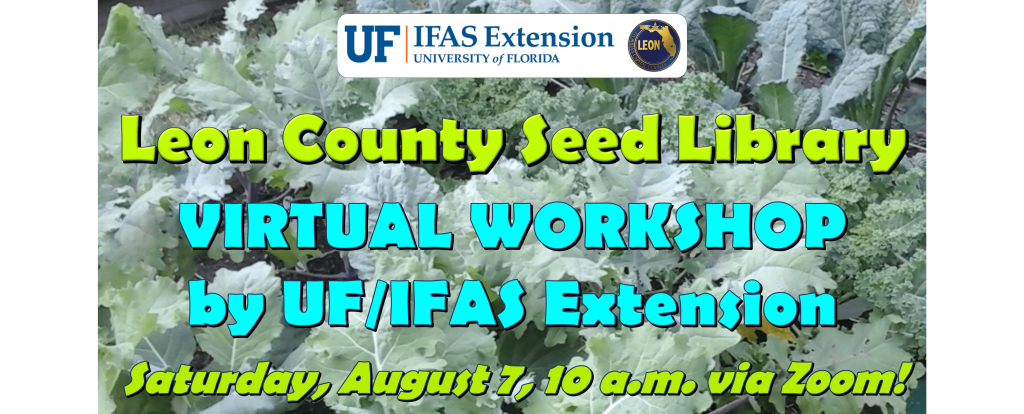
Join us via Zoom on Saturday, August 7, for our Leon County Seed Library Virtual Workshop. Graphic by Molly Jameson.
Join Us August 7 for the 2021 Leon County Seed Library Virtual Workshop
Planting vegetable seeds and growing a garden is a great way to get outdoors and appreciate nature. Since 2015, the Leon County Public Library has supported gardeners in Leon County by providing vegetable seed packets for patrons to take home and plant in their gardens.
To kick off the Fall 2021 Seed Library, agents with UF/IFAS Leon County Extension are hosting the Leon County Seed Library Virtual Workshop on Saturday, August 7, from 10:00 a.m. to 12:00 p.m. via Zoom.
During the virtual workshop, Extension agents will discuss planting seeds, growing vegetables, and how to incorporate veggies into healthy meals and snacks. The workshop coincides with the first day the seeds in the Fall 2021 Seed Library will become available. Residents of Leon County can check out three sample seed packets per month with their library cards from all Leon County library branches.
Even if you are not a resident of Leon County, everyone is welcome to join us at the virtual workshop. Along with the gardening portion of the workshop, there will also be a live virtual cooking demonstration featuring vegetables available in the Fall 2021 Seed Library Program.
For more information about the Leon County Seed Library Virtual Workshop, please visit our Eventbrite page: https://seedlibraryworkshop2021.eventbrite.com. There is no cost to attend the workshop, but registration is required.
If you are a resident of Leon County, all you need is your Leon County library card to check out the vegetable seeds. Don’t have a library card? No problem! Leon County residents can apply online at the LeRoy Collins Leon County Public Library online card application page here: https://lcpl.ent.sirsi.net/custom/web/registration/.
Here is the list of the vegetable seed varieties that will be available starting August 7: Common Arugula, Waltham 29 Broccoli, Chantenay Red Core Carrots, Michihili Chinese Cabbage, Slo-bolt Cilantro, Alabama Blue Collards, Early White Vienna Kohlrabi, Rocky Top Salad Blend Lettuce, Pink Beauty Radishes, and Tokinashi Turnips.
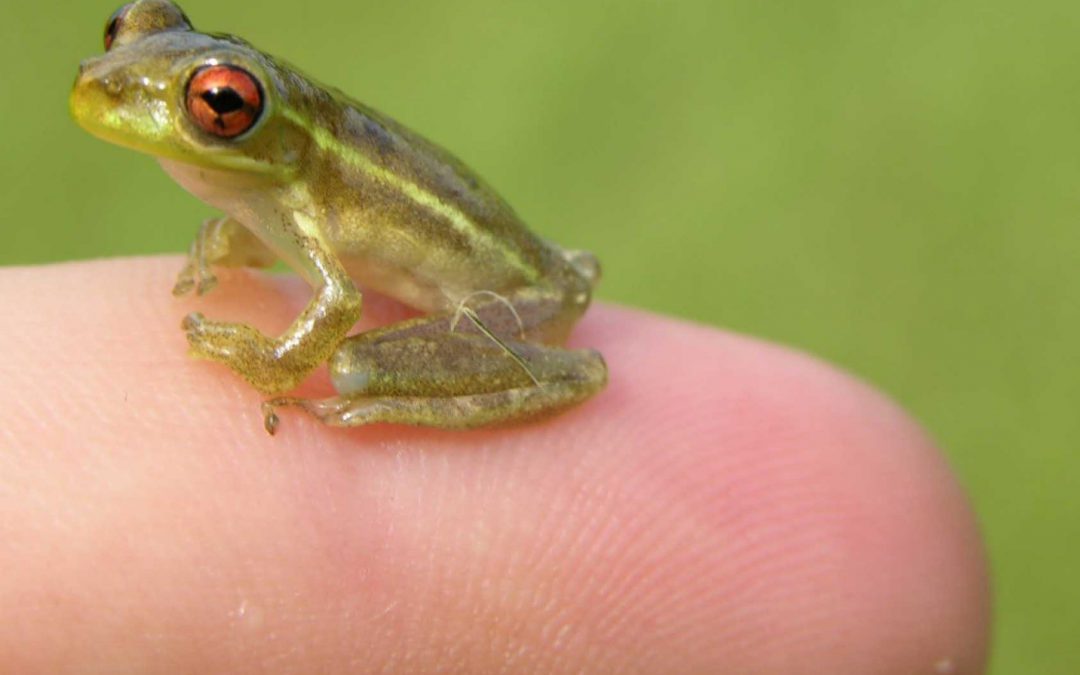
by Sheila Dunning | Jul 15, 2021
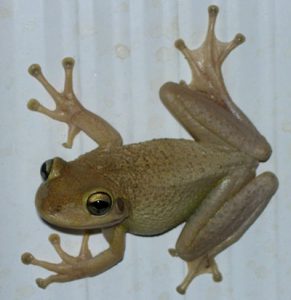
Photo by Dr. Steve Johnson
Treefrog calls are often heard with each rain event. But, how about a “snoring raspy” call that begins after a day time light rain? That may be a male Cuban treefrog trying to attract the girls. Cuban treefrogs breed predominately in the spring and summer. Reproduction is largely stimulated by rainfall, especially warm summer rains such as those associated with tropical weather systems and intense thunderstorms.
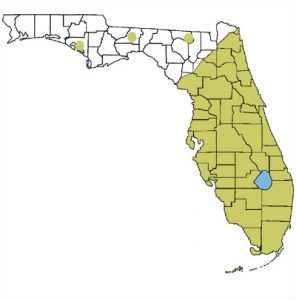
Range of Cuban treefrogs
The Cuban treefrog, Osteopilus septentrionalis, was accidently introduced to Florida in the 1920’s as a stowaway in shipping crates from the Caribbean. Over the last hundred years, the invasive frog has managed to spread throughout Florida and the Southeastern U.S. by hitchhiking on ornamental plants, motorized vehicles, and boats. Though occasional cold winters have created temporary population setbacks, new generations of Cuban treefrogs continue to be reported in north Florida, including the Panhandle.
An invasive species is generally defined as a plant, animal or microbe that is found outside of its native range, where it negatively impacts the ecology, economy or quality of human life. Cuban treefrogs come out at night to feed on snails, millipedes, spiders and a vast array of insects. But, they are also predators of several Florida native frogs, lizards and snakes. Tadpoles of the invasive Cuban treefrog have been shown to inhibit the growth and development of native Southern toad and green treefrog tadpoles when all of the species are in the same water body. Additionally, a large female Cuban treefrog can lay over 10,000 eggs per season in very small amounts of water.
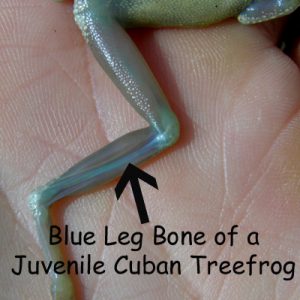 Panhandle citizens can help manage the invasive Cuban treefrog by learning to identify them and reduce their numbers. All treefrogs have expanded pads on the ends of their toes. Cuban treefrogs have exceptionally large toepads. They also have a “big eyed” appearance due to their oversized bulging eyes. Cuban treefrogs may exceed 6 inches in length, have warty-looking skin with possible blotches, bands or stripes, and vary greatly in color. However, they can be distinguished from other treefrogs. Cuban treefrogs have a yellowish wash where their front and rear legs are attached to their body. Juvenile Cuban treefrogs have red eyes and blue bones visible through the skin of their hind legs. The skin of the Cuban treefrog produces a sticky secretion that can cause a burning or itching sensation if it contacts the eyes or nose of certain individuals. It is recommended to wear gloves and wash your hands after handling Cuban treefrogs.
Panhandle citizens can help manage the invasive Cuban treefrog by learning to identify them and reduce their numbers. All treefrogs have expanded pads on the ends of their toes. Cuban treefrogs have exceptionally large toepads. They also have a “big eyed” appearance due to their oversized bulging eyes. Cuban treefrogs may exceed 6 inches in length, have warty-looking skin with possible blotches, bands or stripes, and vary greatly in color. However, they can be distinguished from other treefrogs. Cuban treefrogs have a yellowish wash where their front and rear legs are attached to their body. Juvenile Cuban treefrogs have red eyes and blue bones visible through the skin of their hind legs. The skin of the Cuban treefrog produces a sticky secretion that can cause a burning or itching sensation if it contacts the eyes or nose of certain individuals. It is recommended to wear gloves and wash your hands after handling Cuban treefrogs.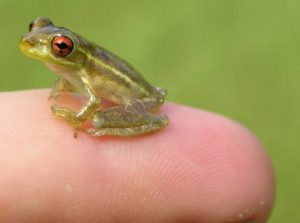
It is important to document the locations of Cuban treefrogs in the Panhandle. By placing short sections of PVC pipe in the ground around your home and garden will provide hiding places for treefrogs that enables you to monitor for Cuban treefrogs. Cut 10 foot sections of 1.5-inch-diameter PVC pipe into approximately three-foot-long sections and push them into the ground about 3-4 inches. To remove a frog from a pipe, place a clear sandwich bag over the top end, pull the pipe from the ground, and insert a dowel rod in the other end to scare the frog into the baggie. If you suspect you have seen one, take a picture and send it to Dr. Steve Johnson at tadpole@ufl.edu. Include your name, date, and location. Dr. Johnson can verify the identity. If it is a Cuban treefrog, upload the information by going to http://www.eddmaps.org/ and click the “Report Sightings” tab.
Once identified as a Cuban treefrog, it should be euthanized humanly. To do that, the Cuban treefrog in a plastic sandwich bag can be placed into the refrigerator for 3-4 hours then transferred to the freezer for an additional 24 hours. Alternatively, a 1-inch stripe benzocaine-containing ointment (like Orajel) to the frog’s back to chemically anesthetize it before placing it into a freezer. After freezing, remove the bagged frog from the freezer and dispose of in the trash. Ornamental ponds should also be monitored for Cuban treefrog egg masses especially after a heavy rain. The morning after a rain, use a small-mesh aquarium net to scoop out masses of eggs floating on the surface of the pond and simply discard them on the ground to dry out. Various objects that can collect water found throughout your yard need to be dumped out regularly to reduce breeding spots for both Cuban treefrogs and mosquitoes.
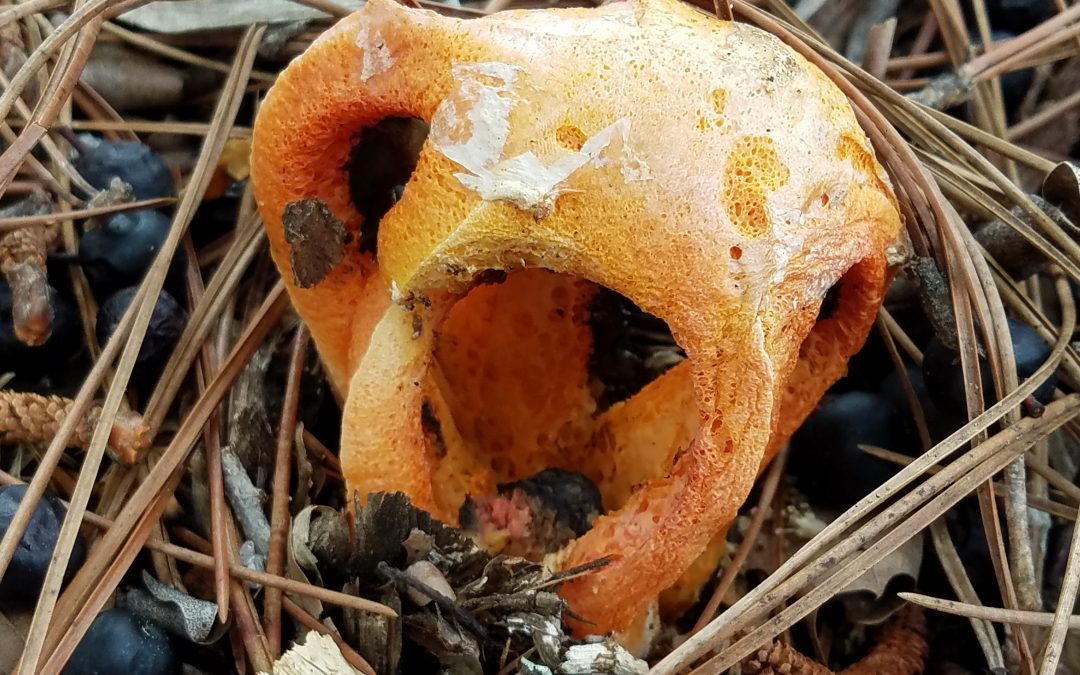
by Evan Anderson | Jul 1, 2021
While there are many fungi that produce mushrooms out in the world around us, there are some that are particularly notable. Edible varieties such as the lion’s mane, jelly ear, and chanterelle may be welcome additions to the landscape. We may have to look out for harmful fungi that cause leaf spots on our landscape plants, toxic mushrooms that could cause harm if ingested, or even things like sooty mold that indicate the presence of another problem (plant-damaging insects, in that case). Then, there are stinkhorn mushrooms.
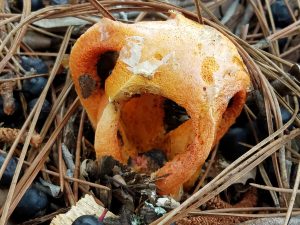
Stinkhorn Mushroom. Photo courtesy of Evan Anderson.
While not poisonous (indeed, some varieties are edible) and not harmful to plants, these mushrooms are usually unwanted by homeowners. Why? There are two things that make them undesirable. First, they emit an odor that may resemble rotting meat, raw sewage, or some delightful combination of the two. Secondly, some species strongly resemble…well, the genus name Phallus may give some indication. Suffice to say that if your landscape mulch appears to have an inappropriate anatomical addition after a cool rain, you may have a stinkhorn mushroom.
These fungi are decomposers of dead plant material, breaking down wood chips, fallen leaves, or old tree stumps. This is an incredibly important role in the ecosystem, but stinkhorns are particularly offensive as they go about doing their job. The reason for their smell, specifically, is because they need to spread their spores. To do so, they attract insects. Unlike many plants which use beautiful flowers with pleasant fragrances to attract pollinators, stinkhorns attract a different crowd of helpers. They exude a slimy mass of spores that are appealing to flies and other invertebrates that enjoy feces, dead animals, and the like. The insects transport spores from place to place as they feed on the slime.
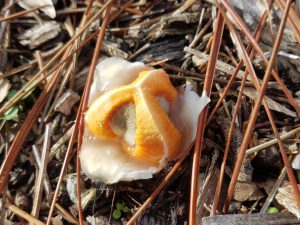
Stinkhorn Mushroom. Photo courtesy of Evan Anderson.
If you smell or see these mushrooms in your yard or landscape, don’t worry. They won’t last long and may be beneficial to the environment. If they become intolerable, stirring mulch up can help discourage their growth, or they can be removed physically (perhaps with a tool or while wearing gloves, at least). If they recur in an area time after time, look out for their early stages of growth, which may resemble puffballs or small eggs, and remove them then. Fungicides tend not to be effective and may harm other beneficial fungi in the environment.
For more information, see our EDIS publication on stinkhorn mushrooms at https://edis.ifas.ufl.edu/publication/PP345.















